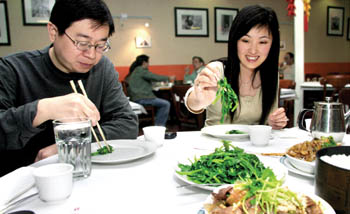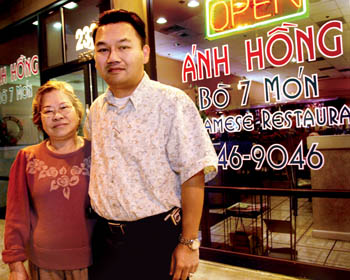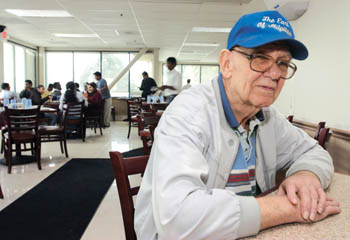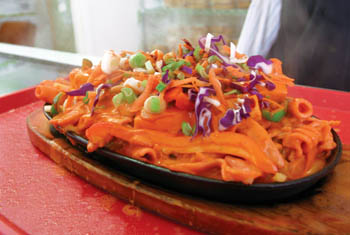![[Metroactive Dining]](/dining/gifs/dining468.gif)
[ Dining Index | Silicon Valley | Metroactive Home | Archives ]

Photographs by Felipe Buitrago A Legend in Its Own Time: Co-owners Ray Huang and Linda Hu sample their own goods at South Legend. Their restaurant is one of the few in Milpitas that are already recognized as destination dining spots throughout the Bay Area. Land of Plenty How Milpitas became the South Bay's premier ethnic dining destination—and why most people still don't know it By Stett Holbrook BACK IN 1985, the Milpitas Business Directory offered a tidy list of the city's restaurants. There were 13 restaurants serving American cuisine, one German restaurant, three seafood/steakhouses and 10 "Oriental" restaurants. "Twenty years ago, it was mainly steak and potatoes," says Gaye Morando, president of the Milpitas Chamber of Commerce. What a difference two decades makes. Since then, the city's white majority has been supplanted by a surging Asian population, and Asian restaurants, particularly Chinese restaurants, as well as Filipino, Vietnamese, Indian, Korean, Thai and Taiwanese, now dominate the city's landscape. Milpitas Square, a 17-acre shopping mall located near the junction of Interstate 880 and Highway 237, has 20 Asian restaurants alone and is the largest Asian-themed mall in Northern California. In short, this northeastern Silicon Valley suburb sandwiched between the 880 and 680 freeways has become the South Bay's premier ethnic dining destination, a fact that's relatively unknown even to most South Bay residents.
Auto Motive The city is perhaps best known to outsiders as home of the Elmwood Jail and the Great Mall of the Bay Area, a sprawling mall that has a freeway exit named after it. It's fitting that a city hemmed by traffic-clogged freeways owes its existence to a car company. In the 1950s, the Ford Motor Co. wanted to build an assembly plant in what was then unincorporated San Jose. Ford needed a city to provide services like water, sewer and trash collection, but the city refused to annex the land. Undaunted, Ford circulated petitions to form Milpitas, and the voters approved. The city was incorporated in 1954. Ford ultimately shut the factory down in 1983, and 10 years later the city retooled the plant and created the Great Mall. At the same time, silicon chip makers, tract housing and more malls were blotting out the city's remaining pear orchards and strawberry fields. While Milpitas is still something of a Silicon Valley backwater, the array of restaurants and markets in the city of 65,000 has made it something special. Sure, San Jose and Los Gatos have got Milpitas beat in white tablecloth fine dining, but for a taste of the real thing—be it from Chengdu, Taipei, Shanghai, Hanoi or Hyderabad—Milpitas is the place. The countless strip malls and shopping centers are an ethnic food lover's paradise. Drive just a few short blocks, and you'll pass family-style Filipino restaurants, bAnh mi and pho joints, Indian sweet shops and pizzerias that offer halal meat toppings. Cross the street and you'll find a Korean tofu house, a dim sum palace and a Chinese noodle restaurant. It goes on and on. "How many suburban towns have as many genuinely interesting dining options as Milpitas?" asks Emily Cannon, a 24-year-old dotcommer who moved to Milpitas from Seattle before relocating to the less restaurant-endowed Campbell. "If you want to catch a quick bite after work, your options include vegetarian Chinese, sushi, teppan, Chinese seafood, Malaysian, noodles, Thai, hot pot and Taiwanese, and that's just in the Milpitas Square strip." Now that the city's bargain-priced Cinema Saver theater is closed, she says the city's main appeals are its proximity to Silicon Valley, the peninsula and the East Bay. That, and the "quantity and quality" of its Asian restaurants. "It's a less dense and more diverse Chinatown," she says. Unlike San Francisco's better-known Chinatown, which has an almost exclusively Cantonese population, Milpitas' Chinese population comes from all over northern and western China, Hong Kong and Taiwan.
Shifting Plates According to the 1990 census, the city had 21,257 white residents and 16,756 Asian residents at that time. By 2000, the white population hadn't budged, but the Asian population had more than doubled to 34,070. These demographic changes have helped give Milpitas a variety of Asian restaurants greater than anywhere else in Silicon Valley. Earl Schmitter is an 80-year-old retired state psychologist who has lived in Milpitas for 39 years. He remembers when he could count the number of restaurants in town on one hand. But that started to change in the 1970s as more Asians began to move into town in search of affordable housing, good schools and well-paying jobs. While some white residents were distressed to see their city change before their eyes, Schmitter welcomed the changes. Especially the food. A self-described "food freak," he used to travel to San Francisco for ethnic food, but now he stays at home. There was a time when he made an effort to visit every new restaurant in Milpitas. "It became impossible," he says. "There was just an explosion." What make Milpitas restaurants unique are their quality and quantity. Because the city is home to so many recent immigrants, the restaurants cater to them. What you often get is non-Americanized, authentic ethnic food made by immigrants for immigrants who want a taste of home. The city is a relatively prosperous one, due in large part to high-tech firms like Cisco Systems and LSI Logic. In 2000, the median income for Milpitas was $84,827, higher than Santa Clara County's median income level. That means there's a busy middle class that has the discretionary income to spend on eating out, and often too little time to cook for themselves. Los Angeles resident Carl Chu wrote Chinese Food Finder: The Bay Area and San Francisco, a guidebook that demystifies the various regional Chinese restaurants in the Bay Area. He's also written Chinese restaurant guides for L.A. and New York City. His pick for the city with the most authentic and varied Chinese food in the Bay Area? Milpitas. "For authenticity I would definitely go there," he says. "There's so much going on, so much change." Milpitas Square is the best place to begin an exploration of the city's culinary renaissance. It's emblematic of the city at large: it's new, it's prosperous and it's Asian. And it's filled with great food. Open since 1996, the faux Mission and Italian villa architecture belies the culinary treasures that lie within. Ranch 99 supermarket, an Asian food odyssey in itself, anchors the shopping center. At lunchtime, tech workers from the nearby Cisco campus and elsewhere pour into the shopping center. Even with 1,100 parking spaces, the lot fills up quickly. Follow the Crowds With so many restaurants, it's hard to decide where to go. When in doubt, I follow the crowds. There are several restaurants that are consistently mobbed. Nutrition House may sound like a vitamin store, but it's one of the mall's best restaurants. It specializes in Dongbei cuisine, hearty meat and potatoes food from China's blustery northeast, a region bordered by Russia, Mongolia and North Korea. Maybe it was the rainy weather that attracted people to this cold-weather food; on my visits there was a crowd of people huddled in front of the fish tank near the front door waiting for a table. The menu lists dozens of dishes made in "Dongbei style," braised in a thick and dark gravylike sauce redolent of onions, black vinegar, soy sauce and low, sweet flavors. Potatoes are seldom seen on a Chinese menu, but they are a specialty here. Try the potato with green pepper—noodley strands of potato stir-fried with peppers in a light, garlic-laced sauce. Best of all is the Dongbei-style spicy tofu, a beef and tofu dish the glowed with the pleasantly numbing power of Szechuan peppercorns. At the opposite end of the mall, Darda Seafood Restaurant is another crowd pleaser. Darda is one of the South Bay's few Islamic Chinese restaurants and it focuses on the cuisine of western China, a rugged land that borders the Muslim countries of Kazakhstan, Kyrgyzstan and Tajikistan. The meat here is all halal, meaning it was butchered in accordance with Islamic law. And there's no pork. In spite of its name, I think the beef and lamb dishes outshine the seafood at Darda. Steamed dumplings filled with savory, ginger-seasoned beef cloaked in meaty red sauce are a great starter. Northern and western China are known for their noodles, and Darda's are excellent. Look around and most people are slurping down a bowl. Three-flavor hot noodle soup combines shrimp, squid, beef and vegetables in a deep, rich broth. Beef chow mein with homemade noodles features lean slices of beef and fat, flat and chewy knife-shaved noodles. To make these, the cook cuts raw noodles from a block of dough and drops them in boiling water. Each noodle is a slightly different size and their rough surface is great for soaking up sauce. Darda's menu also includes several lamb dishes, a hallmark of western Chinese food. Chinese pickled cabbage with spicy lamb is great. ABC Seafood is one of Milpitas Square's biggest draws. The cavernous restaurant is one of Milpitas' premier dim sum restaurants. (There's also ABC across town that's equally good, but under different ownership.) This is the place where families gather for banquets and celebration dinners. The display case near the hostess stand holds a large dried shark fin, a sign of the wealthy clientele ABC Seafood attracts. Shark fin is an expensive and rather tasteless delicacy that confers social status on those who serve it to their guests at wedding or birthday banquets. The shark fin trade is also the focus of an international campaign aimed at ending the brutal practice of "finning," hacking the fins off live animals and then dumping the bleeding sharks overboard where they sink rudderless to the bottom and die. Thankfully, more restaurants are taking shark fin off the menu. Across town, South Legend Sichuan Restaurant is one of the few restaurants to gain notoriety outside the city limits. The restaurant has drawn praise from yours truly and food writers at San Francisco magazine and the San Francisco Examiner. The restaurant, located on a restaurant-dense strip of North Milpitas Boulevard, serves true Szechuan fare. Many Chinese restaurants include a few token Szechuan items, but this is all Szechuan, all the time. Co-owner Bill He said he spent two years trying to find the right location for his restaurant and finally settled on Milpitas two years ago because of its accessibility and large Chinese population. In what may be a first for a Milpitas restaurant, he's contemplating opening a second, more upscale Szechuan restaurant in Palo Alto. The menu offers an encyclopedic list of Szechuan dishes. The owners and chefs are from Chengdu, the capital of Szechuan cooking. While primarily known for its prodigious use of chile peppers and Szechuan peppercorns, Szechuan food is also prized for its complex tastes and contrasting textures. Many Szechuan dishes have fanciful names with stories behind them. Couple beef, also known as "husband and wife beef," is a cold meat dish that began as a Chengdu street snack in the 1930s. It takes its name from the couple who invented it. It consists of tender, slow-cooked slices of beef brisket and delicate slices of tripe. It's all bathed in more fiery chile oil and topped with ground peanuts and cilantro. The contrasting flavors and textures of the meat are also said to represent the yin and yang of man and woman. Kung pao chicken ($6.95), called gong bao on the menu, is one of the most common Chinese restaurant dishes, but few people realize its Szechuan origin. "Every Chinese restaurant serves gong bao chicken or shrimp or whatever but the original is from Szechuan," says He. "We make it the traditional way." The dish of diced chicken, bright chiles and crunchy peanuts is finer than other versions I've had. The light sauce is spicy, sweet and sour, contrasting but complementary flavors that are classically Szechuan. Another not-to-miss dish is the Chen ma po tofu. The dish translates as "pock-marked mother Chen's tofu" and is named after the smallpox-scarred woman who popularized the dish. Silky cubes of tofu float in a gorgeous red broth spiked with crushed roasted chiles. Ground pork and sliced green onions are scattered on top. It's an exotic yet comforting dish.
Other Influences Although not as well represented as Chinese restaurants, Milpitas also has several excellent Indian restaurants. Much of the Bay Area's Indian food consists of nondistinct northern and southern Indian food, but Milpitas has several restaurants that focus on particular regions. Tirupathi Bhimas features the fiery, vegetarian-friendly food of Andhra Pradesh, a southeastern state on the Bay of Bengal. The restaurant's vegetable biryani, uthappam (rice and lentil pancakes topped with vegetables) and thali (combination plates) are particularly good. My favorite Indian restaurant is the oddly named Milan Sweet Center. Located in an Abel Street minimall next to a Korean barbecue restaurant, Milan specializes in the sweets and snacks of Gujarat, a coastal state that borders Pakistan and the Arabian Sea. Inside, the restaurant is dominated by a large glass display case. One side is packed with a rainbow-colored assortment of burfi, halwa and other sweet treats, flavored with pistachio, cardamom and other exotic spices I can't identify. The staff is friendly and patient with all my pointing and asking, "What's this? What's that?" The other side is filled with salty and crunchy snacks that look like different kinds of Chex mix. Just as good is the menu of chaat (small plates of food), vegetable curries and thali plates. Vietnamese food also shines in Milpitas. Anh Hong co-owner Michael Le says it was his great grandmother who, back in Vietnam, created "beef seven ways," an elegant seven-course meal that is now a standard in Vietnamese restaurants (see this week's Menu). The restaurant also turns out exquisitely cooked traditional Vietnamese dishes. A soup of crispy shrimp wonton surpasses its lackluster name. Plump fried wontons stuffed with meaty chunks of flavorful shrimp add body to a broth of incredible complexity and depth built from layer upon layer of chicken and pork stock accented with dried shrimp and squid. Banh xeo, which appears on many Vietnamese restaurant menus, is a specialty of the house; the mother of the Le brothers shows a deft hand at creating a greaseless crepe, crisp on the outside, tender on the inside and subtly infused with the flavors of coconut and turmeric and bursting with goodies inside. There's also the beef, the heart of the business. If you want to try the beef, but don't want seven courses of it, the beef carpaccio pairs paper-thin slices of raw beef with an addictive salad that could forever change your idea of coleslaw—shredded carrot, celery and daikon radish are tossed with roasted onions, fresh herbs and an invigorating fish sauce�based dressing with a touch of sweetness and kick of chile peppers. In some ways, Milpitas embodies what's wrong with modern suburbia. The city paved over its farmland (Milpitas means "little corn field" in Spanish) and covered it with miles of car-dependent development and one homogenous-looking shopping mall after another. Today, Milpitas has no discernible city core and Main Street is no longer the main street. While there are good schools, safe streets and a city budget flush with retail tax revenue, Milpitas would be a forgettable Silicon Valley suburb if it weren't for all that wonderful food. For the food fan, the city has become Silicon Valley's land of plenty. With scores of restaurants I haven't tried and new ones opening on what seems like a weekly basis, I'll return and again.
Send a letter to the editor about this story to letters@metronews.com. [ Silicon Valley | Metroactive Home | Archives ]
|
From the January 11-17, 2006 issue of Metro, Silicon Valley's Weekly Newspaper.
Copyright © 2006 Metro Publishing Inc. Metroactive is affiliated with the Boulevards Network.
For more information about the San Jose/Silicon Valley area, visit sanjose.com.


